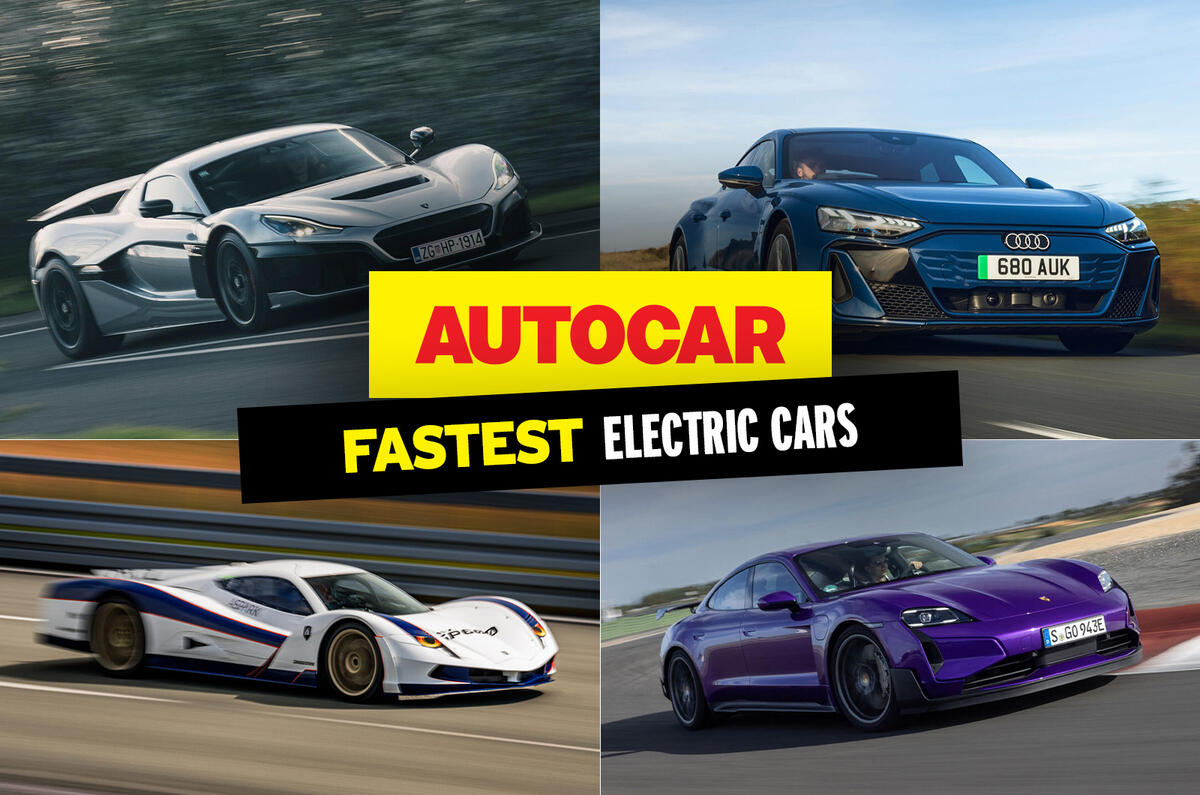Ranked: The fastest electric cars
Gone are the days when buying an EV meant pottering around in a Nissan Leaf. Now, EVs are proper speed machines

News
by Jack Warrick
7 mins read
3 March 2025
Share
When electric cars first launched into the mainstream, they utilised early technology and didn’t exactly push the boundaries of performance.
The likes of the Peugeot iOn and Citroën C-Zero, launched in 2009, were a sign of things to come, but they were notoriously slow (both to drive and to charge).
Things have come a long way since then and some electric cars have risen into the upper echelons to become the world’s fastest cars.
Now, the latest generation of battery-powered hypercars is banishing all memories of bumbling milk floats and the weedy G-Wiz.
They smash speed records and ace acceleration tests, and it’s not hard to see why they deliver their devastating performance. Electric motors are powerful and compact and deliver all their torque instantly for an unrivalled response.
Some of these cars have as many as four eclectic motors, each finely controlled which allows for the precise pouring of power so that not a single horsepower is wasted. What’s more, new lithium-ion batteries feature sophisticated thermal management systems that allow them to deliver their full potential all the time.
But which is the fastest electric car yet? The car that officially holds that accolade is the Rimac Nevera. It hits 0-62mph in a staggering 1.8sec, so blink and you’ll quite literally miss it.
This list features ten of the world’s fastest electric cars, with game-changing technology from Lotus, Porsche and Lucid, plus a few surprise inclusions… So read on, and hold on to your hats…
1. Aspark Owl
10
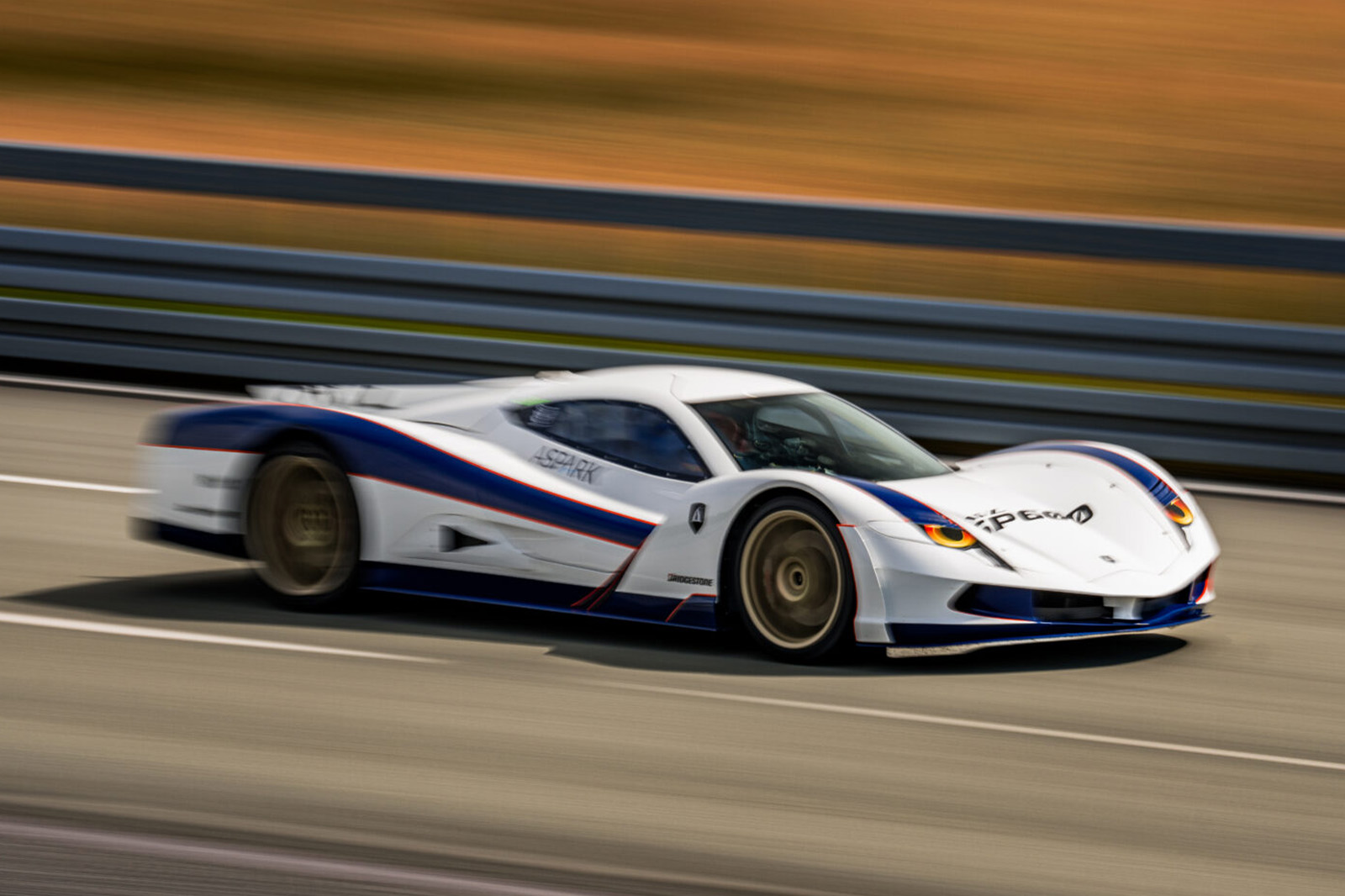
- Design8
- Interior8
- Performance10
- Ride & Handling9
- Costs6
Pros
The fastest electric car in the world
Vicious looks
Cons
Just 50 to be made…
… at £2.5 million each
Japan’s nascent electric hypercar company has wasted no time in staking its claim to the title of ‘world’s quickest car’. It is without question one of the fastest cars ever built.
It set two world records in 2023, completing an eighth of a mile at an average speed of 192.03mph (309.02kph) and the quarter mile at an average speed of 198.12mph (318.85kph).
Roll on November 2024, where it achieved a Guinness world record for the fastest battery-powered electric prototype hypercar in the world, hitting a top speed of 273 miles per hour.
Powered by four electric motors with a staggering combined output of 1985bhp, the Owl has already rattled off the 0-60mph sprint in 1.72sec, and its creators reckon there’s the potential to shave a further few tenths from this figure.
Its specially developed 64kWh battery gives a claimed range of 280 miles. Aspark plans to build just 50 examples of the Owl, each priced at a cool £2.5 million.
Raed more about the Aspark Owl
Latest Reviews

Used Jaguar XF 2015-2024 review
8
Used Jaguar XF 2015-2024 review

MG S5 EV
8

Fiat 500e
6

Nissan Ariya Nismo
6

Suzuki Swift
8
Read our review
Car review

Porsche Taycan Turbo GT
Porsche’s long-awaited 1000-horsepower performance EV is a serious GT department effort
Back to top
2. Rimac Nevera
10
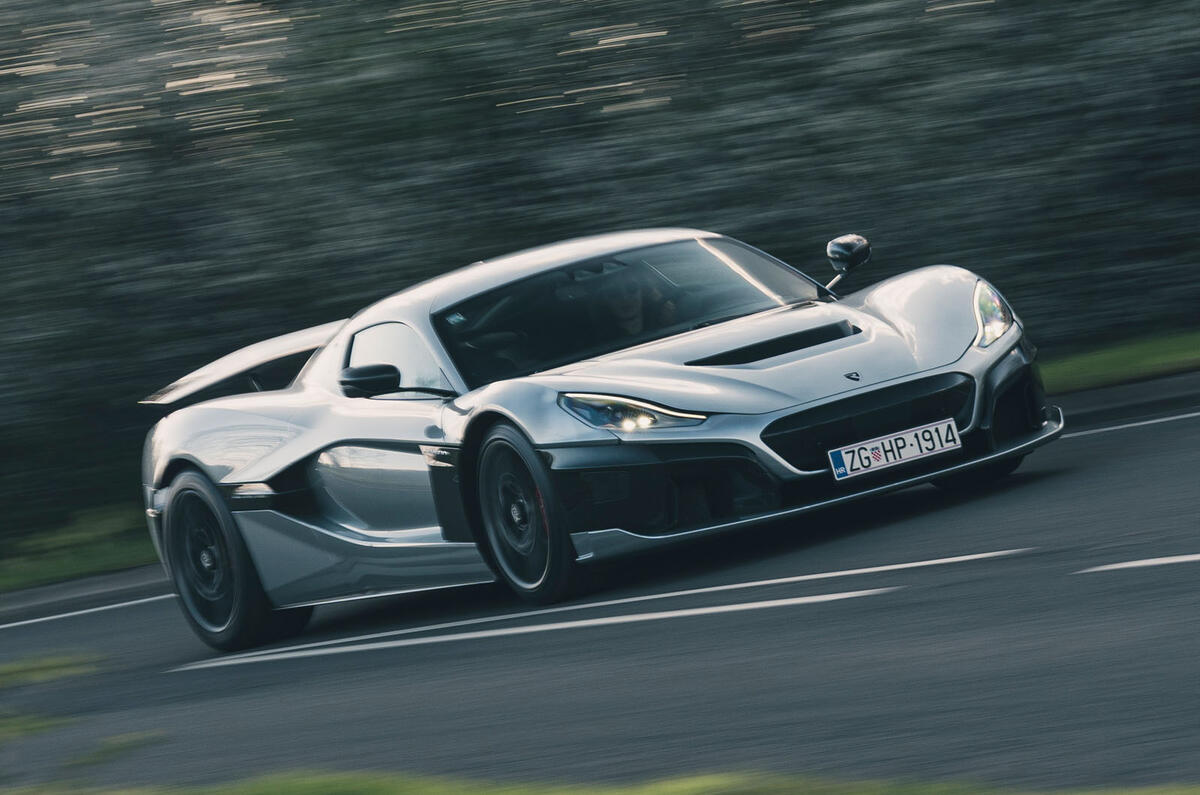
- Design9
- Interior8
- Performance10
- Ride & Handling10
- Costs7
Pros
More power than a Bugatti
Almost 2000bhp
Cons
Bloomin’ expensive
Nevera R is faster still
Rimac the company has gone from almost nothing to EV industry leader as quickly as its flagship Nevera gets from 0-60mph (it takes 1.85 seconds for the record, while 185mph comes up in just 11.8 seconds).
With investment from Porsche and now part of the Bugatti family, the Croatian firm has got the jump on many established manufacturers when it comes to high-performance electric car tech.
In the warm and dry and on a straight road, the Nevera accepts an astonishing amount of power without fuss in what is an extremely uncomfortable experience for my insides.
The Nevera itself is a carbon fibre-bodied two-seater that packs four torque vectoring motors (one for each wheel) with a total output of 1887bhp.
These are powered by a 120kWh battery that promises 340 miles between charges, a number that’s almost as eye-catching as the £2 million price.
There’s a higher-powered version – the Nevera R – on the way, too. That car gets 2078bhp and a 0-62mph sprint of 1.81sec. And it’ll hit 186mph faster than a Volkswagen Golf will hit the national speed limit…
Read our Rimac Nevera review
Read more about the Rimac Nevera R
3. Pininfarina Battista
8
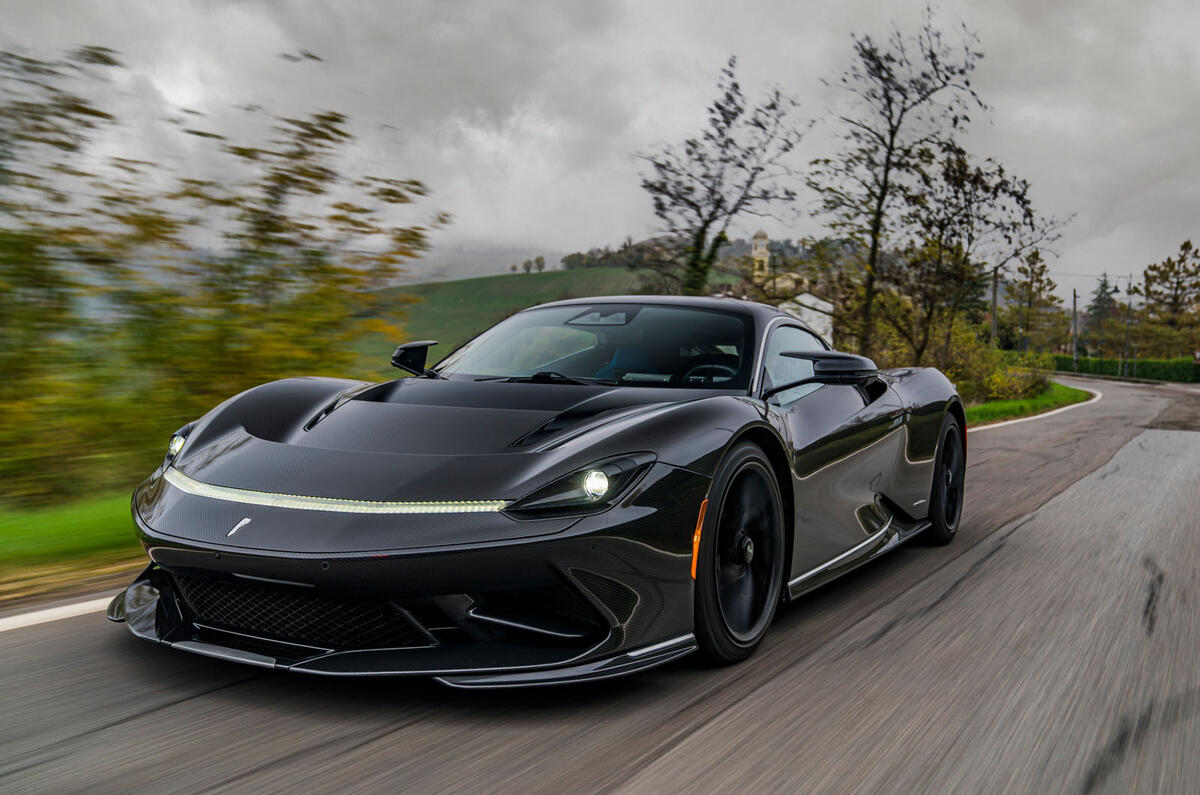
- Design8
- Interior8
- Performance10
- Ride & Handling8
- Costs6
Pros
Not just a Nevera in a frock
Incredible power
Cons
It’s quite heavy for a hypercar
Almost £2 million
Under the Battista’s curvaceous carbon fibre skin is the same powertrain used in the Rimac Nevera.
With four motors and a combined output of 1876bhp, performance is ferocious and the company claims a 0-62mph time of less than 2.0sec.
In the Battista, the front ones make 335bhp apiece and the rears 603bhp each. Any one of them would be enough; all four together make the full 1876bhp.
Despite being closely related to the Rimac, the two share only about 50% of their components, so the 150 purchasers of the £2 million Pininfarina will be getting a bespoke machine.
In fact, the Italian styling house says the Battista is more of a grand tourer than the rather rawer Rimac.
Read our Pininfarina Battista review
Read more about the Pininfarina Battista
Back to top
4. Lotus Evija
9
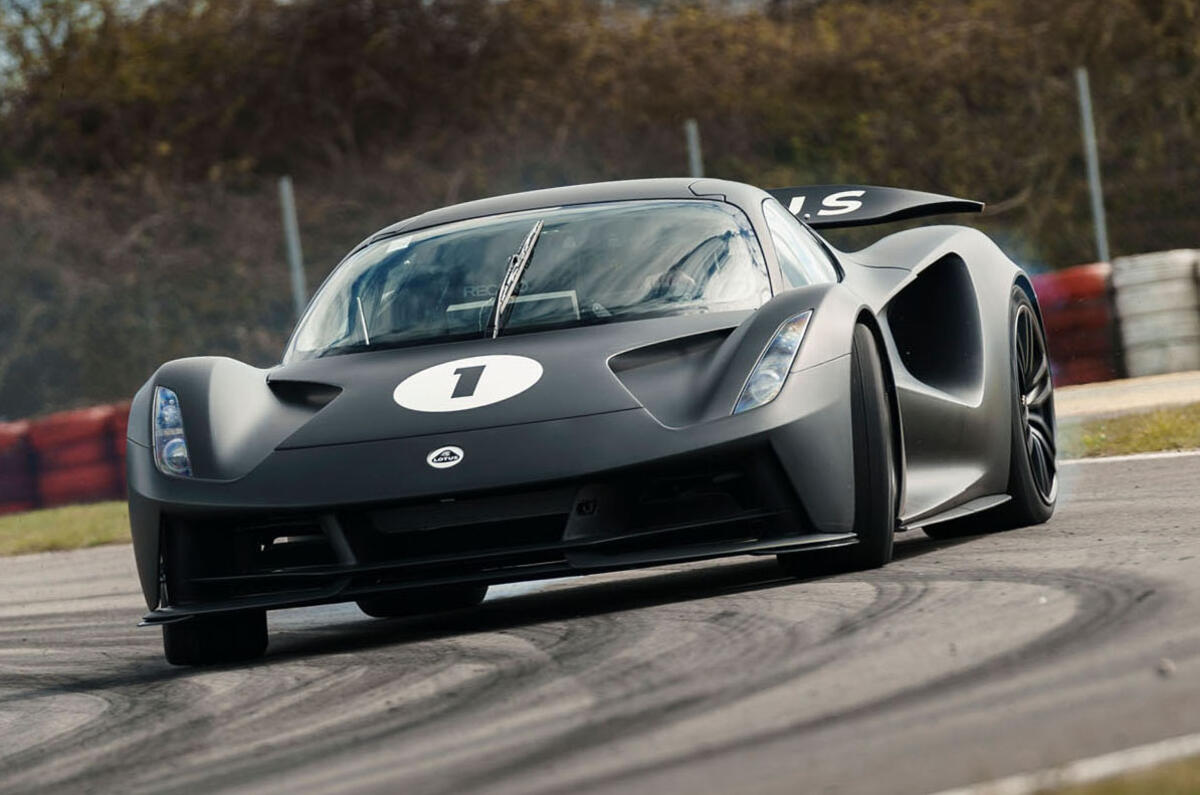
- Design8
- Interior8
- Performance10
- Ride & Handling8
- Costs6
Pros
Hugely impressive
Super cool styling
Cons
Cars are only just reaching customers
Freakishly quiet
Four years after its initial debut, the first Lotus Evija production cars have finally started to reach their very patient owners.
The 2011bhp Evija is not only one of the fastest electric cars on sale but also one of the fastest cars ever built. Lotus claims it can sprint from 0-62 mph in “less than three seconds,” but it can also accelerate from 0 to 190mph in a staggering 9.1se.
The lack of an engine and gearshifts definitely alters the experience of pushing a hypercar on track, much more so than when driving a regular EV on road.
Even so, while the performance figures attract the headlines, Lotus is keen that its mid-engined machine stays true to the firm’s lightweight roots and delivers on its reputation for thrilling handling.
A target mass of 1700kg looks a little hefty in isolation, but it undercuts many similar electrically powered supercars, while its carefully developed driver modes and four-wheel torque vectoring have already impressed us in a brief drive of a prototype.
Read our Lotus Evija review
Read more about the Lotus Evija
5. Porsche Taycan Turbo GT
9
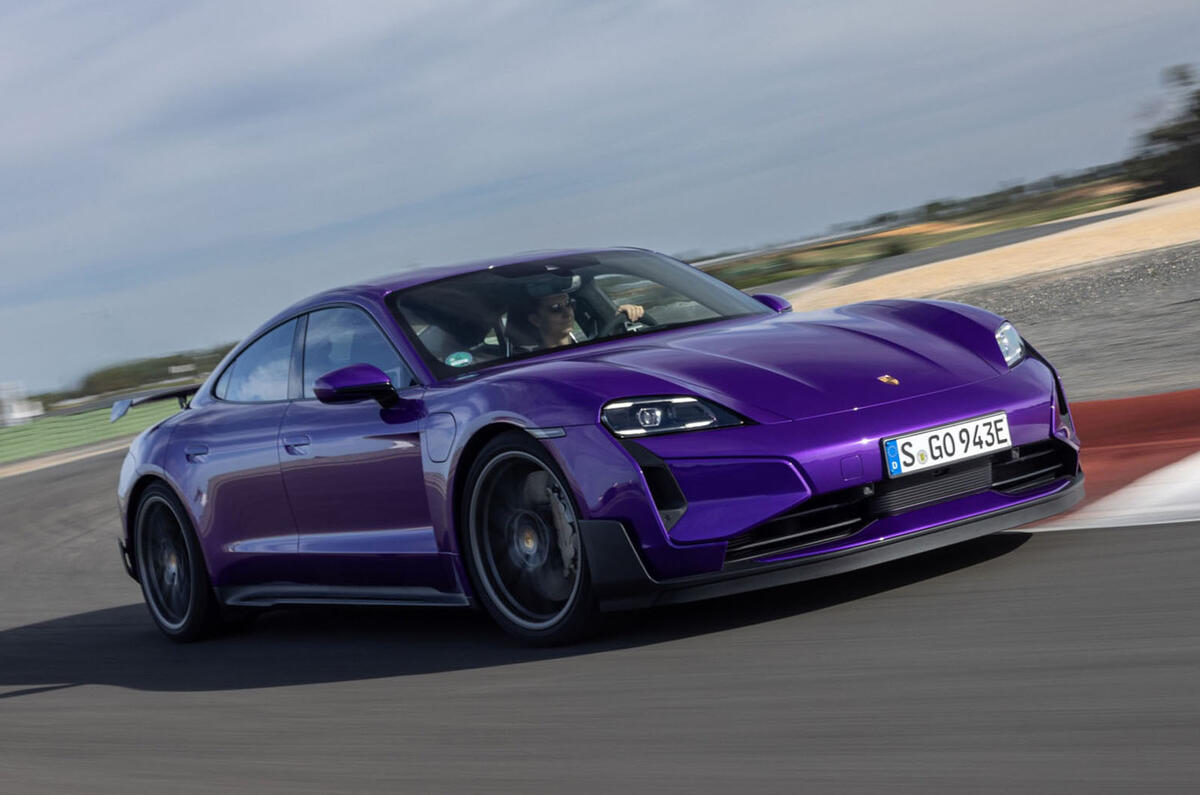
- Design8
- Interior8
- Performance10
- Ride & Handling8
- Costs6
Pros
Feels almost hypercar-fast off the line
Massive performance isn’t a corrupting influence on handling
Cons
Weighs 2.2 tonnes
It doesn’t have the combustive drama we’re used to from GT department Porsches
Any Taycan you choose will be brilliantly quick, but none more so than the Porsche Taycan Turbo GT, which is one of the fastest electric cars money can buy today.
It uses the same battery and twin-motor hardware as a Taycan Turbo S and dials it up to 11 thanks to software derived from Porsche’s Formula E exploits. Total power stands at 1093bhp and 988lb ft, which means 0-62mph in a face-melting 2.2sec.
The Porsche Taycan Turbo GT can play the all-conquering GT department track car with enormous pace, and very well – to a point
If you’re not keen on having your foot to the floor at all times, though, you’ll be able to take advantage of the Taycan’s big 105kWh battery, which is good for 345 miles of range.
Add the Weissach package and you’ll also get a larger rear wing, more aerodynamic underbody panels and you’ll also drop 70kg in weight thanks to lighter glass, removal of the back seats and other components.
Read our Porsche Taycan Turbo GT review
Save money on a Porsche Taycan with What Car?
Back to top
6. Lucid Air
9
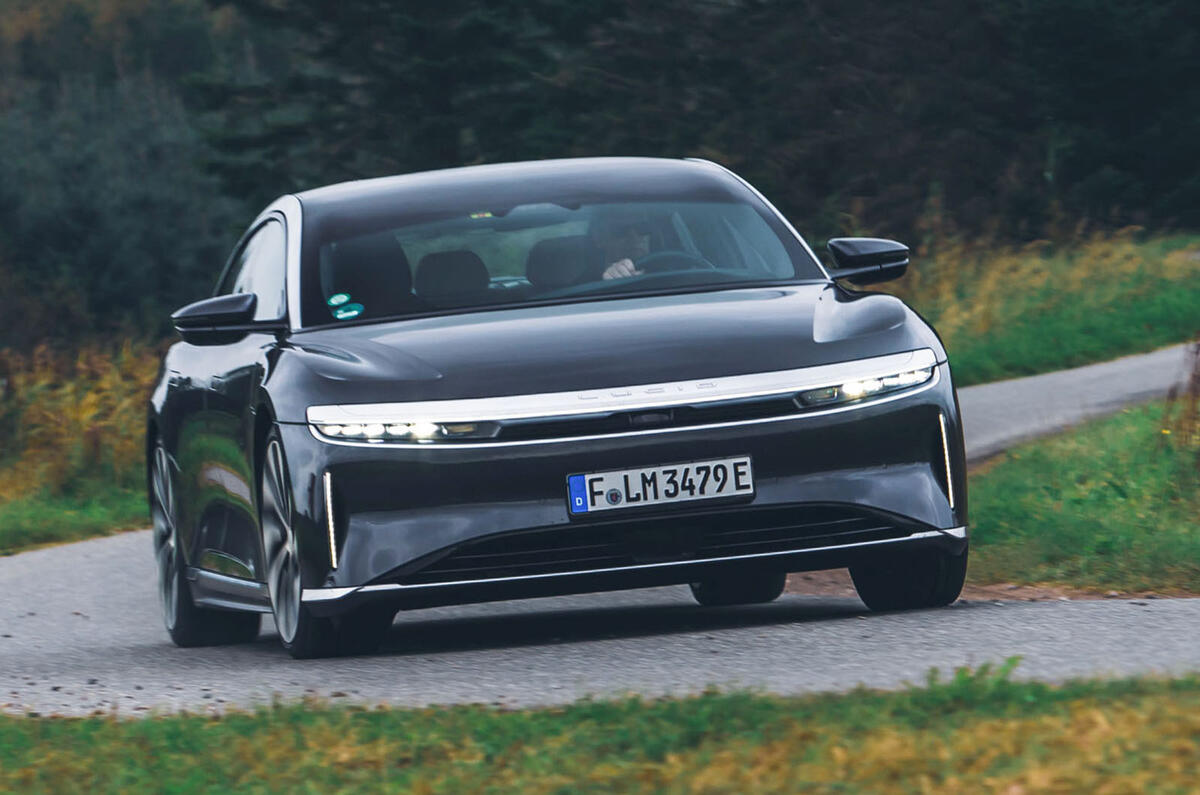
- Design9
- Interior8
- Performance10
- Ride & Handling8
- Costs8
Pros
Huge performance
Huge range
Cons
Still hasn’t come to the UK
Arguably one of the most eagerly anticipated EVs of the year, the enigmatically titled Lucid Air isn’t short of headline-grabbing numbers.
Developed in California and featuring jaw-dropping concept car looks, in flagship Dream Edition guise the luxurious four-door saloon promises up to 1065bhp from twin electric motors, promises a top speed of 235mph and claims it’ll travel 520 miles between recharges.
The Air does its best work as a truly innovative, efficient and desirable luxury saloon, and this is the direction in which Lucid should hone the car.
Of course it’s quick off the mark too, despite weighing just over two tons, and can zap from standstill to 60mph in just 2.5 seconds.
It’s not just the car itself that’s fast either, because it’s claimed the Air can handle rapid charging of up to 300kW, meaning 300 miles of range can be added in only 20 minutes.
Now, come on Lucid. Get it into the UK!
Read our Lucid Air review
7. Tesla Model S Plaid
7
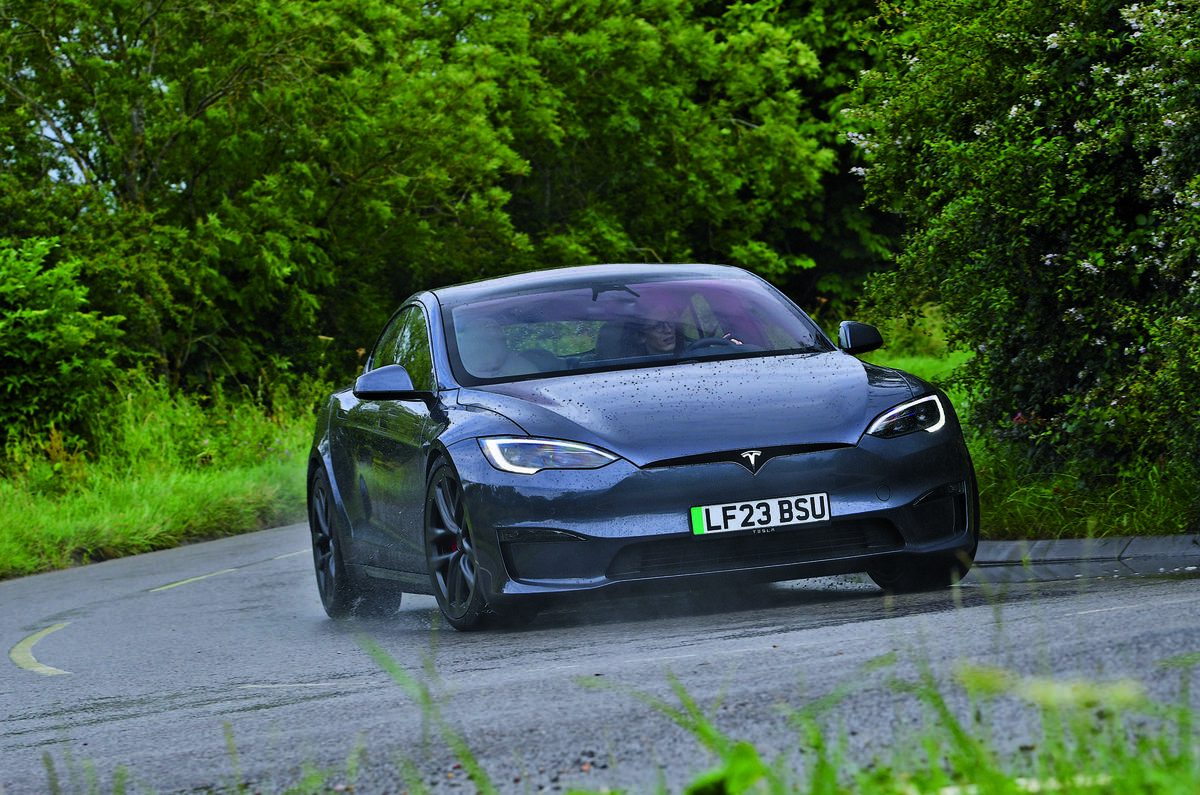
- Design8
- Interior7
- Performance9
- Ride & Handling7
- Costs7
Pros
Mind-bending performance
Great efficiency
Cons
Lacks handling finesse
Left-hand drive only
The Model S Plaid is only available from stock and in left-hand-drive in the UK, but that doesn’t stop it from being one of the fastest electric cars on sale.
The brand’s flagship saloon isn’t wasting any time hanging about, with its 1006bhp tri-motor layout delivering the 0-60mph sprint in a claimed 1.99 seconds.
While the Plaid is sufficiently pleasant on the daily grind, its refinement isn’t enough of a distinguishing feature to excuse the handling, which is at best lacklustre
Bear in mind the brand uses the North American roll-out acceleration standard, which only starts timing the run after the car’s moved about a third of metre. In reality, this shaves around a tenth of a second from the true standing start figure.
Our tests actually measured a more accurate time of 2.4sec in its most intense driving mode. Regardless, that’s certainly nothing to scoff at and is faster than a Bugatti Veyron Super Sport.
Yes the Model S’s handling remains as involving as a conversation with a dry stone wall, but for out and out acceleration there’s not a four-door family car in the world that can touch the Tesla.
Read our Tesla Model S Plaid review
Save money on a used Tesla Model S with What Car?
Back to top
8. Audi E-tron GT RS Performance
8

- Design9
- Interior8
- Performance9
- Ride & Handling8
- Costs7
Pros
Staggering point-to-point pace
Superbly refined
Cons
Rear leg room is a weakness compared with the Lotus Emeya
Prices start at nearly £110,000
Lots of changes were made to the Audi E-tron GT at the end of 2024, including efficiency boosts, weight saving and, most importantly in the context of this list, performance.
In its most powerful form, the E-tron GT RS Performance, you’ll get dual motors and 912bhp (with launch control) and will be blasted from 0-62mph in just 2.5sec.
With the upgraded battery pack and significantly improved efficiency, this E-tron GT is much more capable of actual grand touring than the original.
If you do manage to drain the batteries (an easy task, trust us), you’ll be able to take advantage of the E-tron GT’s 320kW charging speed. Audi also claims up to 365 miles on a charge, but our real-world tests achieved closer to 280 miles.
While the RS Performance is indeed blisteringly fast, we’d argue you don’t even need all that power. Our pick of the range is the S with 671bhp, which already feels seriously quick.
Read our Audi E-tron GT RS Performance review
Save money on a used Audi E-tron with What Car?
9. Maserati GranTurismo Folgore
7
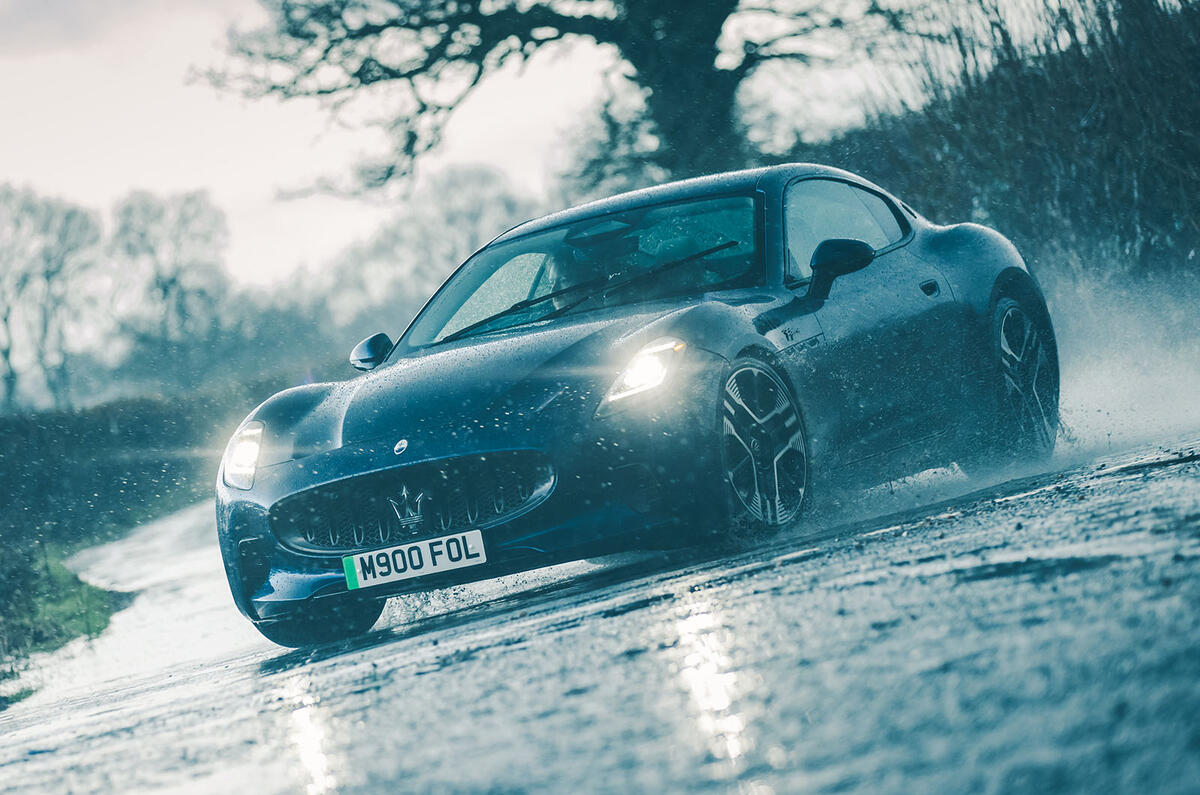
- Design8
- Interior8
- Performance9
- Ride & Handling7
- Costs5
Pros
Tremendous straight-line performance
Easygoing handling and plenty of composure
Cons
Sounds unexciting, to state the obvious
More expensive than a Taycan Turbo S
While it’s late to the EV party, Maserati has made sure it’s made a big entrance.
Based on its all-new GranTurismo sportscar, which has been engineered to accommodate both ICE and electric powertrains, the Italian newcomer is packed with cutting edge kit designed to boost performance.
It is rather a likeable machine, despite lacking the overt sonic charm of Granturismos of yesteryear and carrying around with it nearly 2.4 tonnes.
Three electric motors (two at the rear and one at the front) provide 751bhp, which combine with the weight-saving aluminium construction to help the Maserati streak from 0-62mph in 2.7 seconds.
The Folgore also gets 800V architecture that allows rapid DC charging of the battery from 20 to 80% in as little as 18 minutes. Better still, it’s good to drive, the rapid acceleration joined by agile and engaging torque-vectored handling.
Read our Maserati GranTurismo Folgore review
Save money on a new Maserati GranTurismo with What Car?
Back to top
10. Tesla Model 3 Performance
8

- Design8
- Interior7
- Performance9
- Ride & Handling8
- Costs9
Pros
A fraction on the price of any other car on this list
Incredible performance
Cons
Questionable interior decisions
Ride still leaves a lot to be desired
The second Tesla on this list isn’t the Cybertruck or the long-awaited (and likely non-existent) Roadster, but the firm’s smallest car: the Tesla Model 3.
While the standard car offers enough power to shift you from 0-62mph in just 5.8sec, the Model 3 Performance gets 618bhp, all-wheel drive and will hit the same figure in just 2.9sec. It’ll go on to a top speed of 163mph.
The fact remains that the Model 3 is simply an enjoyable thing to rub along with on a daily basis, and quality improvements also mean it feels like the premium offering the brand has always claimed it to be.
Range stands at an impressive 328 miles, but it’s unlikely you’ll hit that figure if you let yourself enjoy the Model 3’s full potential.
As well as comfort seats, adaptive suspension and forged performance wheels, this range-topping Model 3 is filled with carbon fibre trim to make is appear even more sporty,



